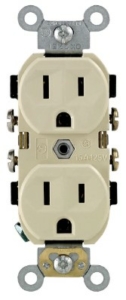Two Conductor Wire
Prior to 1962 homes were wired with two conductor wire. This means there was a hot wire (black wire) and a neutral wire (white wire). The hot wire is the electricity coming to the outlet from the electrical panel/grid. The neutral wire is the path back to the electrical panel/grid for the electricity. The issue is, if the neutral wire became disconnected, then the electricity needed to find an alternate path back to Earth. Consequently, that path could be a person or a piece of equipment.
Starting in 1962 there was a requirement for three conductor wire to be used on all outlets in a home. Three conductor wire still had a hot wire and a neutral wire, but it introduced a third ground wire (bare copper or a green wire). The idea of the ground wire is if the neutral wire became disconnected, then the ground wire provides the primary path back to Earth versus a person or a piece of equipment.
Options
So what options do you have if you have a home built with two conductor wire? There are several options.
- The least feasible option is to rewire the house. This would be very invasive and very costly. However, if you are doing a remodel and gutting the home, this would be the most desirable option.
- The next option would be to run ground wires to each outlet. This is not much more feasible that the first option.
- The last option is to replace the two conductor outlets with three prong GFCI outlets. It is important to note that regular three prong outlets should not be used unless the are protected by a GFCI outlet and properly labeled.
What Code Says!
While we are not code inspectors, NEC 406.4(D)(2) allows for option 3 above as follows:
406.4(D)(2) Non–Grounding-Type Receptacles. Where attachment to an equipment grounding conductor does not exist in the receptacle enclosure, the installation shall comply with (D)(2)(a), (D)(2)(b), or (D)(2)(c).
(a) A non–grounding-type receptacle(s) shall be permitted to be replaced with another non–grounding-type receptacle(s).
(b) A non–grounding-type receptacle(s) shall be permitted to be replaced with a ground-fault circuit interrupter-type of receptacle(s). These receptacles shall be marked “No Equipment Ground.” An equipment grounding conductor shall not be connected from the ground-fault circuit-interrupter- type receptacle to any outlet supplied from the ground-fault circuit-interrupter receptacle.
(c) A non–grounding-type receptacle(s) shall be permitted to be replaced with a grounding-type receptacle(s) where supplied through a ground-fault circuit interrupter. Grounding-type receptacles supplied through the ground-fault circuit interrupter shall be marked “GFCI Protected” and “No Equipment Ground.” An equipment grounding conductor shall not be connected between the grounding-type receptacles.
What Does This Mean?
Here is what this means in layman’s terms.
(a) An existing two prong outlet can be replaced with another two prong outlet. This does nothing to change the situation you are reading this article for.
(b) An existing two prong outlet can be replaced with a three prong GFCI outlet. GFCI outlets come with stickers that should be attached to the outlet’s cover plate reading “No Equipment Ground”.
(c) An existing two prong outlet can be replaced with a three prong outlet that is protected by another three prong GFCI outlet. These three prong outlet’s cover plates should be labeled “GFCI Protected” and “No Equipment Ground”.
What Should I Do Next?
We hope this article has given you a better understanding of what is two conductor wire and the options that exist to upgrade. We recommend that you consult with a licensed electrician. Additionally, the licensed electrician may suggest other options.





